In the summer of 1892, Auctioneers Salter Simpson & Sons, received instructions to sell a ‘choice farm’ in Great Ellingham.
The sellers were referred to as the “Devisees in Trust for Sale under the Will of the late Mr Robert Land.”
The Farm
The printed Auction Particulars also tell us that the ‘choice farm’ comprised a House and Premises together with several enclosures of “Excellent Accommodation Arable Land”. The whole farm consisted of 112 acres 3 roods and 12 perches and was referred to as ‘Town Green Farm’.
The farm, which was ‘in a high state of cultivation’, was occupied by Mr J Downes. The Particulars describe John Downes as “a most desirable tenant“.
Given that I understand John Downes occupied the farm known as ‘Chestnut Grove Farm’ and not the farm which today is known as ‘Town Green Farm’, I am thankful that there is a plan attached to the Auction Particulars.
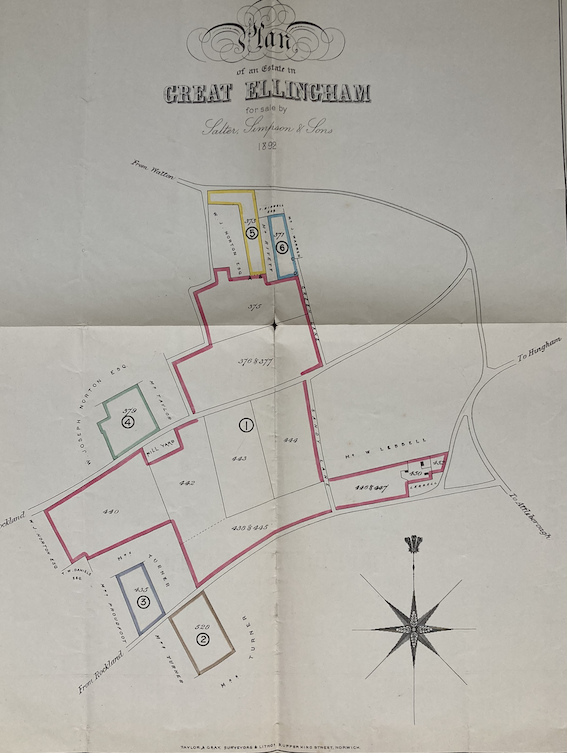
Plan annexed to 1892 Auction Particulars re Town Green Farm, Great Ellingham. Courtesy David Ewin
‘Chestnut Grove Farm’ & ‘Town Green Farm’
It is clear from the above plan that the farm referred to in the Auction Particulars as ‘Town Green Farm’ is indeed what became known as ‘Chestnut Grove Farm’.
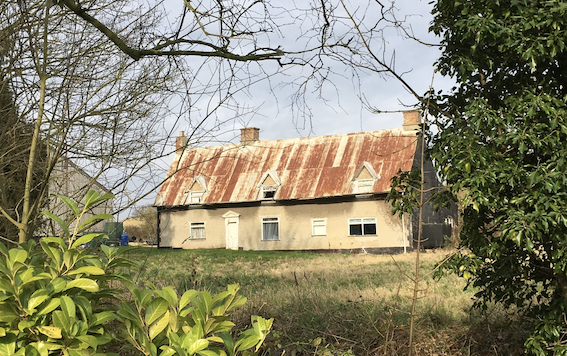
Chestnut Grove Farm House. Photograph taken February 2019
The property we know today as Town Green Farm lies to the north of this farm.
The Auction Particulars and the plan also describe the property and land in six lots. These are:
Lot 1
A Most Desirable Farm known as ‘Town Green Farm’, comprising a comfortable clay & thatched residence, with two sitting rooms, entrance hall, store room, back kitchen, cellar, dairy with chamber above, two staircases, four bed rooms, coal house, garden, small orchard, pump with Farm Premises, including barn, cow yards and sheds, cow house, gig house, stable, horse yards and sheds, straw house and Newly erected bullock shed with yard, cart and wagon lodge with granary above, fowls’ house and loose boxes with Several enclosures of highly productive arable and pasture land containing in all, 92 acres 2 roods and 23 perches.
Lot 1 sold for £2,000
Lot 2
A valuable enclose of Accommodation Arable Land. Known as “Ladies Land” the freehold piece of land comprised 5 acres 1 rood and 36 perches.
Lot 2 sold for £160
Lot 3
An enclosure of ‘Accommodation Arable Land’ and known as “Pennell Lands”. The piece of freehold land comprised 3 acres 3 roods and 16 perches.
Lot 3 sold for £92 10s
Lot 4
A parcel of excellent arable land known as “Mill Five Acres” which contained 5 acres and 28 perches.
Lot 4 sold for £145. The purchaser was Mr William J Norton, the then owner of ‘Rookery Farm’
Lot 5
An enclosure of arable land known as “Williamson’s”. It contained 3 acres 2 roods and 13 perches and adjoined Lot 1.
At the end of the present occupier’s tenancy, the purchaser of this lot is expected to block up the existing entry to Lot 1, between the points marked A to B on the plan.
Lot 5 sold for £127. This piece of land was also purchased by William Norton.
Lot 6
A piece of accommodation arable land and known as “Sallow Bush”. It comprised 2 acres and 27 perches and is near to Green Lane.
This lot is accessed from Lot 1. However, this access will be blocked up but the purchaser will be able to make an entry from the Green Lane between the points C to D on the plan.
Lot 6 sold for £52 10s
Occupier John Downes
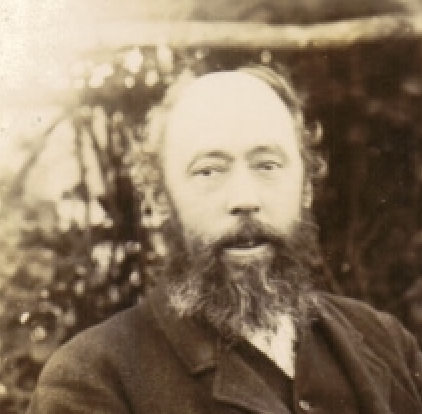
John Downes. Taken from a photograph courtesy Joan Barnard
I do not know who purchased the main farm as described as Lot 1.
However, I believe John Downes occupied the farm from at least 1891. At this time, the farm appears to be known as ‘Chestnut Grove’. It is puzzling why the Auction Particulars refer to the farm as ‘Town Green Farm’.
Although both the census returns of 1891 and 1911 state that John Downes was at ‘Chestnut Grove Farm’, Kelly’s Directories of 1904, 1908 and 1912 list John Downes at ‘Cottage Farm’ – yet another name for most likely the same farm!
Nevertheless, Kelly’s of 1925 lists Basil Jude at ‘Town Farm’ and Algernon Melton (John Downes’s grandson) at Chestnut Grove Farm.
Despite the change of ownership in 1892, John Downes continued to occupy the farm. I wonder whether he purchased it?
The Sellers – The Devisees of Robert Land’s Will
Will & Codicil
Nearing the age of 80, Robert Land made his last Will and Testament on the 15th May, 1882. He described himself as a ‘Gentleman’ of Attleborough.
Robert appointed his friend, Carteret George Ellis, and his three surviving sons, Edmund, Charles and Tom, as his executors and trustees.
On the 11th September, 1885, (just two days before his death), Robert Land added a codicil to his will. The codicil did not change any of the bequests, gifts or legacies in Robert Land’s will. However Robert Land gave his trustees directions regarding sums of money lent between his sons, as well as authority to settle any Banker’s account (again relating to his sons) for which Robert Land is responsible (or accountable).
Probate
Robert Land’s will was proved by Carteret George Ellis, Charles Land and Tom Land in 1886, with power reserved to Edmund Land.
Remaining Executors & Trustees
However by the time the farm was sold in 1892, both Charles and his brother Edmund had died. Accordingly, the farm was sold by Carteret Ellis and Tom Land – the remaining executors and trustees of Robert Land’s will.
What do we know about Robert Land?
He was born in Caston, a village just over 4 miles to the west of Great Ellingham.
Robert married Mary Beart in Breckles on the 20th November, 1827.
Children
The couple began married life in Caston, with Robert Land finding work as a bricklayer. The couple had seven known children:
| Born | |
| Robert Beart Land | 11 June 1828 |
| Mary Abigail Land | 22 January 1830 |
| Martha Esther Land | 13 January 1831 |
| Edmund | 8 January 1832 |
| Emma Susanna | 9 March 1833 |
| Charles Alfred | 30 November 1834 |
| Tom | 21 March 1839 |
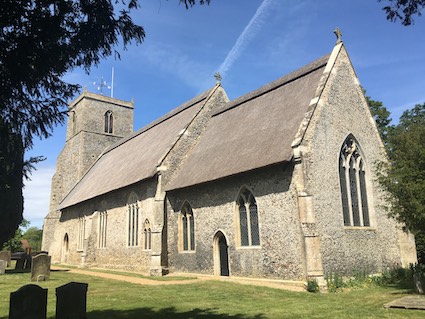
The Church of the Holy Cross, Caston. Photograph taken May 2020
The children were baptised in the Church of the Holy Cross, Caston.
Sadly, Martha died before reaching her second birthday.
1851 census
The 1851 census captures the Land family living in Hockham.
At 46, Robert Land is described as a land agent and a farmer of 440 acres. He employs 14 men, 3 boys and 2 girls.
His Larling born wife Mary is also 46 and two of their children – Emma 18 and Charles 15 – are with their parents. The household is supported by two house servants.
The couple’s other surviving children are at Bridge Farm, Caston.
Headed by 23 year old Robert B Land, the household comprises his siblings 20 year old Mary, 18 year old Edmund and 12 year old Tom. This household also has a house servant. Robert Land is described as a farmer of 112 acres and employs 5 labourers.
1881 census
By 1881, Robert Land had retired.
The census of that year finds 77 year old retired farmer Robert Land with his 75 year old wife Mary living in London Road, Attleborough. With the couple is their widowed 49 year old daughter-in-law Emma Land. The Lands employ 30 year old Hannah Estell as a domestic servant.
Death of Robert Land
Robert Land died at his home in Attleborough on the 13th September, 1885. Three years earlier, he had ‘put his affairs in order’ by drawing up his will.
Robert Land’s Properties
Land purchased the farm at Town Green, Great Ellingham from John Barnard in February, 1858. Barnard died a month later.
The farm was one of several properties owned by Robert Land. Indeed at the time of his death, Robert Land also owned houses and land in Attleborough, Caston, Wramplingham and Thetford. He lived with his wife, Mary, in one of his houses in Attleborough.
The Contents of Robert Land’s Will
With the auction of the Great Ellingham farm taking place several years after Robert Land’s death, it is no surprise to find that Robert Land bequeathed life tenancies in most of his properties – and not outright gifts.
Further by the time Robert signed his will in 1882, he and his wife Mary had just three surviving children – sons, Edmund, Charles and Tom. However by that time, they had several grandchildren.
Great Ellingham Property & Land
Robert Land bequeathed a life interest in all his property and land in Great Ellingham to his son Edmund. However this was on the condition that Edmund keep the dwellinghouse and all other buildings in good and tenantable repair, and insured.
Having only a life interest in the property, Edmund’s ‘ownership’ would cease on his death. However, he would benefit from the income from the rents of the Great Ellingham farm during his lifetime.
When Edmund Land died, Robert Land directed his executors and trustees to sell the property.
Other Properties & Land
Attleborough & Wramplingham
Robert Land gave a life interest in his Attleborough properties to his son, Charles Alfred Land. However, this excluded Robert Land’s home in Attleborough which he shared with his wife Mary.
Tom Land received a life interest in his father’s properties and land in Caston and Wramplingham.
However these gifts were with the same conditions as Robert Land set out for the life tenancy of the Great Ellingham property i.e. that the life tenant must maintain and insure the properties.
On the death of each of the respective life tenants, Robert Land also instructed his executors and trustees to sell the properties. The proceeds from the sales would be distributed in accordance with certain trusts set out in Robert Land’s will.
Thetford
Land directed his executors and trustees to sell his properties in Thetford as soon as possible after his death. The proceeds from these sales were then to be divided equally between his three surviving sons, Edward, Charles and Tom, ‘share and share alike’ (i.e. an equal share).
Attleborough Home
Robert Land gave his wife Mary a life interest in their home in Attleborough. She was also allowed to have the sole use of all the household goods, chattels and effects as well as Robert Land’s horses, carriages and other outdoor effects. Again, this interest would cease upon her death.
The Attleborough dwellinghouse, gardens, land, ground and premises (presumably in London Road), then passed to her youngest son, Tom, who would also inherit (absolutely) all the household goods and effects as well as the horses, carriages etc.
Legacies
Robert Land left various other legacies, some of which were fairly substantial. These legacies included monetary gifts to a niece and nephew who were then living in America.
Edmund Land – New Owner of the ‘Town Green Farm’
On his father’s death in 1885, Edmund Land became the owner of the ‘Town Green Farm’ in Great Ellingham.
Like his father before him, Edmund Land never lived at the farm. Accordingly, the farm would have continued to be tenanted.
1881 census
The 1881 census captures 49 year old Edmund Land with his wife Maria at their farm in Thompson. Edmund Land is farming some 400 acres and employing 6 men and 2 boys.
Death of Edward Land
Edmund Land’s ownership of the Great Ellingham farm came to an end on his death on the 7th January, 1892.
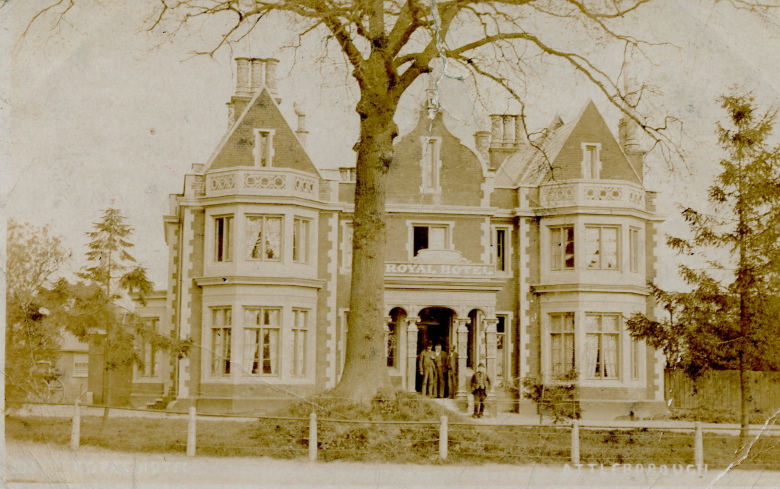
The Royal Hotel, Attleborough
In accordance with his father’s will, the Great Ellingham farm was ‘put up’ for sale and consequently sold at the auction held at the Royal Hotel, Attleborough on the 11th August, 1892.
Sources:
24 May 1886. Probate of the Will with one Codicil of Robert Land, Gentleman of Attleborough. Died 13 September 1885. Copy obtained via https://www.gov.uk/search-will-probate
Auction Particulars for auction at the Royal Hotel Attleborough 11 August 1892. Private Deeds collection
Caston Parish Registers. Norfolk Record Office. PD 158. Transcription viewed via Norfolk Family History Society website
Breckles Parish Registers. Norfolk Record Office. PD 533. Viewed via www.ancestry.co.uk
Thompson Parish Registers. Norfolk Record Office. PD 156. Viewed via www.ancestry.co.uk
1851 census HO107/1823/285, HO107/1823/217
1881 census RG11/1974/19, RG11/1975/103
1753-1847 Manor of Buckenham Castle, Lathes, Close and Priory. Court Book. Norfolk Record Office. Catalogue Ref: MC 1833/8 -MC 1833/16. 1595-1847 also available at https://www.familysearch.org